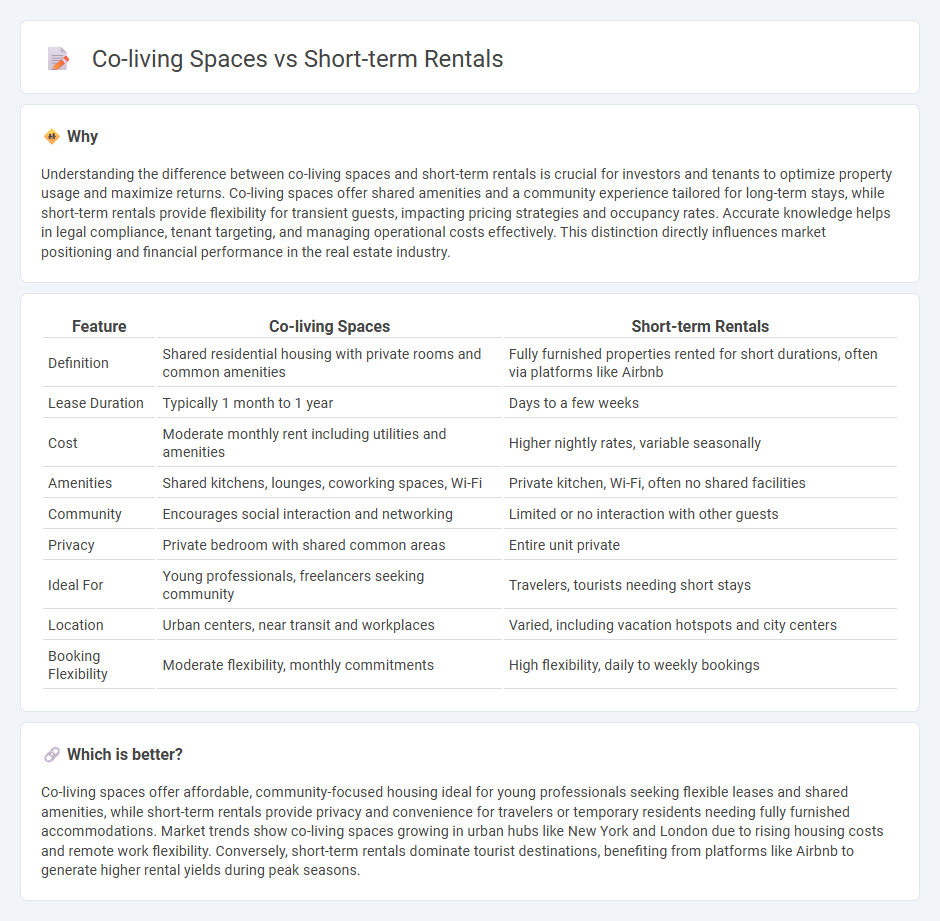
Co-living spaces offer affordable, community-oriented housing with shared amenities, catering primarily to young professionals and digital nomads seeking flexible, long-term stays. Short-term rentals, such as those listed on platforms like Airbnb, provide fully furnished accommodations ideal for travelers or transient residents requiring temporary lodging from a few days to several months. Explore the benefits and challenges of co-living spaces versus short-term rentals to find the best housing solution for your needs.
Why it is important
Understanding the difference between co-living spaces and short-term rentals is crucial for investors and tenants to optimize property usage and maximize returns. Co-living spaces offer shared amenities and a community experience tailored for long-term stays, while short-term rentals provide flexibility for transient guests, impacting pricing strategies and occupancy rates. Accurate knowledge helps in legal compliance, tenant targeting, and managing operational costs effectively. This distinction directly influences market positioning and financial performance in the real estate industry.
Comparison Table
| Feature | Co-living Spaces | Short-term Rentals |
|---|---|---|
| Definition | Shared residential housing with private rooms and common amenities | Fully furnished properties rented for short durations, often via platforms like Airbnb |
| Lease Duration | Typically 1 month to 1 year | Days to a few weeks |
| Cost | Moderate monthly rent including utilities and amenities | Higher nightly rates, variable seasonally |
| Amenities | Shared kitchens, lounges, coworking spaces, Wi-Fi | Private kitchen, Wi-Fi, often no shared facilities |
| Community | Encourages social interaction and networking | Limited or no interaction with other guests |
| Privacy | Private bedroom with shared common areas | Entire unit private |
| Ideal For | Young professionals, freelancers seeking community | Travelers, tourists needing short stays |
| Location | Urban centers, near transit and workplaces | Varied, including vacation hotspots and city centers |
| Booking Flexibility | Moderate flexibility, monthly commitments | High flexibility, daily to weekly bookings |
Which is better?
Co-living spaces offer affordable, community-focused housing ideal for young professionals seeking flexible leases and shared amenities, while short-term rentals provide privacy and convenience for travelers or temporary residents needing fully furnished accommodations. Market trends show co-living spaces growing in urban hubs like New York and London due to rising housing costs and remote work flexibility. Conversely, short-term rentals dominate tourist destinations, benefiting from platforms like Airbnb to generate higher rental yields during peak seasons.
Connection
Co-living spaces and short-term rentals both respond to the growing demand for flexible, community-oriented housing solutions in urban real estate markets. These models leverage shared amenities and adaptable leasing terms, attracting millennials and remote workers seeking affordability and convenience. Real estate investors capitalize on this synergy by optimizing occupancy rates and maximizing rental yields through diversified property usage.
Key Terms
Lease Agreement
Short-term rental lease agreements typically offer flexible terms ranging from days to months, catering to travelers and temporary residents with minimal commitments. Co-living space leases often extend over longer periods, structured to promote community living with shared amenities and clear policies on communal spaces. Explore the key differences in lease terms and tenant obligations to find the best fit for your living needs.
Occupancy Rate
Short-term rentals typically experience fluctuating occupancy rates influenced by seasonal demand and local events, often ranging between 50% to 75%. Co-living spaces, designed for longer-term stays, maintain higher and more stable occupancy rates, frequently surpassing 85%, due to community-driven living and inclusive amenities. Explore detailed occupancy statistics and trends to determine which housing model best fits your investment goals.
Community Amenities
Short-term rentals often provide individualized amenities such as fully furnished kitchens and private bathrooms, catering to transient guests seeking convenience and privacy. Co-living spaces emphasize shared community amenities like communal kitchens, coworking areas, and social lounges designed to foster interaction and collaboration among residents. Explore more about how these community features shape your living experience and choice between short-term rentals and co-living spaces.
Source and External Links
What is Considered a Short-Term Rental? - GovOS - Provides an overview of short-term rentals, including categories like entire homes and accessory dwellings.
Short Term Apartments For Rent in Hanover Park IL - Lists available short-term rentals in Hanover Park, IL, offering flexible leases and amenities.
Short-Term & Temporary Housing - Extended Stay America - Offers temporary housing with amenities like fully furnished units and utilities included, ideal for business travel or relocation.
 dowidth.com
dowidth.com